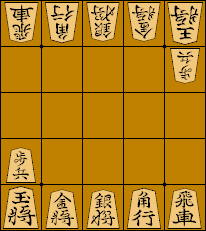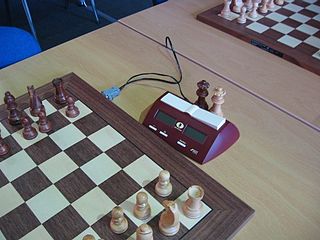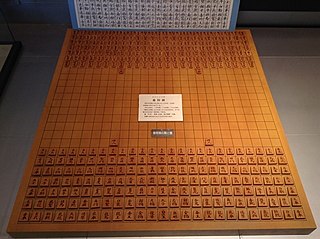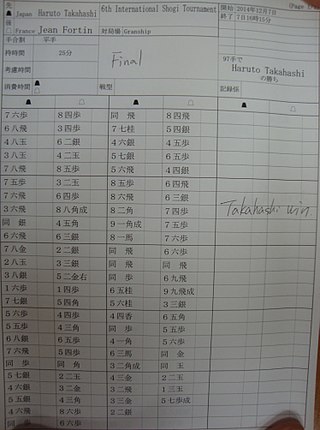
Shogi, also known as Japanese chess, is a strategy board game for two players. It is one of the most popular board games in Japan and is in the same family of games as Western chess, chaturanga, xiangqi, Indian chess, and janggi. Shōgi means general's board game.

Minishogi is a modern variant of shogi. The game was invented around 1970 by Shigenobu Kusumoto of Osaka, Japan. The rules are nearly identical to those of standard shogi, with the exception that it is played on a 5x5 board with a reduced number of pieces, and each player's promotion zone consists only of the rank farthest from the player.

In chess, promotion is the replacement of a pawn with a new piece when the pawn is moved to its last rank. The player replaces the pawn immediately with a queen, rook, bishop, or knight of the same color. The new piece does not have to be a previously captured piece. Promotion is mandatory when moving to the last rank; the pawn cannot remain as a pawn.

Chu shogi is a strategy board game native to Japan. It is similar to modern shogi in its rules and gameplay. Its name means "mid-sized shogi", from a time when there were three sizes of shogi variants that were regularly being played. Chu shogi seems to have been developed in the early 14th century as a derivative of dai shogi. There are earlier references, but it is not clear that they refer to the game as we now know it.

Tai shogi is a large board variant of shogi. The game dates to the 15th century and is based on earlier large-board shogi games. Before the discovery of taikyoku shogi in 1997, tai shogi was believed to be the largest playable chess variant, if not board game, ever. One game may be played over several long sessions and require each player to make over a thousand moves. It was never a popular game; indeed, a single production of six game sets in the early 17th century was a notable event.

Microshogi is a modern variant of shogi, with very different rules for promotion, and demotion. Kerry Handscomb of NOST gave it this English name. Although not confirmed, he credits its invention to the late Oyama Yasuharu, one of the most famous professional shogi players in history. The game was invented before 1982.
Yari shogi is a modern variant of shogi ; however, it is not Japanese. It was invented in 1981 by Christian Freeling of the Netherlands. This game accentuates shogi’s intrinsically forward range of direction by giving most of the pieces the ability to move any number of free squares orthogonally forward like a shogi lance. The opposite is true of promoted pieces which can move backward with the same power.
Tsume shogi or tsume (詰め) is the Japanese term for a shogi miniature problem in which the goal is to checkmate the opponent's king. Tsume problems usually present a situation that might occur in a shogi game, and the solver must find out how to achieve checkmate. It is similar to a mate-in-n chess problem.
Judkins shogi is a modern variant of shogi, however it is not Japanese. Credit for its invention has been given to Paul Judkins of Norwich, UK, prior to April 1998.
Heian shōgi is a predecessor of modern shogi. Some form of the game of Chaturanga, the ancestor of both chess and shogi, reached Japan by the 9th century, if not earlier, but the earliest surviving Japanese description of the rules dates from the early 12th century. Unfortunately, this description does not give enough information to actually play the game, but this has not stopped people from attempting to reconstruct this early form of shogi.
Shō shōgi is a 16th-century form of shogi, and the immediate predecessor of the modern game. It was played on a 9×9 board with the same setup as in modern shogi, except that an extra piece stood in front of the king: a 'drunk elephant' that promoted into a prince, which is effectively a second king. While 9×9 may not seem 'small', it was smaller than the other shogi variants prevalent at the time, which were the 12×12 chu shogi and 15×15 dai shogi. According to the Sho Shōgi Zushiki, the drunk elephant was eliminated by the Emperor Go-Nara, and it is assumed that the drop rule was introduced at about the same time, giving rise to shogi as we know it today.

Kyoto shogi is a modern variant of shogi. It was invented by Tamiya Katsuya c. 1976.
Heian dai shogi is an early large board variant of shogi as it was played in the Heian period. The same 12th century document which describes the Heian form of shogi also describes this variant. Unfortunately, this description does not give enough information to actually play the game, but this has not stopped people from attempting to reconstruct this early form of shogi. A fairly complete and playable reconstruction is outlined here.
Dai shogi or Kamakura dai shogi (鎌倉大将棋) is a board game native to Japan. It derived from Heian era shogi, and is similar to standard shogi in its rules and game play. Dai shogi is only one of several large board shogi variants. Its name means large shogi, from a time when there were three sizes of shogi games. Early versions of dai shogi can be traced back to the Kamakura period, from about AD 1230. It was the historical basis for the later, much more popular variant chu shogi, which shrinks the board and removes the weakest pieces.

Tenjiku shogi is a large-board variant of shogi. The game dates back to the 15th or 16th century and was based on the earlier chu shogi, which itself was based on dai shogi.

Maka dai dai shōgi is a large board variant of shogi. The game dates back to the 15th century and is based on dai dai shogi and the earlier dai shogi. The three Edo-era sources are not congruent in their descriptions of the pieces not found in smaller games. Apart from its size and number of pieces, the major difference from these smaller games is the "promotion by capture" rule. A more compact modern proposal for the game is called hishigata shogi.
Sannin shōgi, or in full kokusai sannin shōgi, is a three-person shogi variant invented circa 1930 by Tanigasaki Jisuke and recently revived. It is played on a hexagonal grid of border length 7 with 127 cells. Standard shogi pieces may be used, and the rules for capture, promotion, drops, etc. are mostly similar to standard shogi. While piece movement differs somewhat from standard shogi, especially in the case of the powerful promoted king, the main difference in play is due to the rules for voluntary and mandatory alliance between two of the three players.
Shogi, like western chess, can be divided into the opening, middle game and endgame, each requiring a different strategy. The opening consists of arranging one's defenses and positioning for attack, the middle game consists of attempting to break through the opposing defenses while maintaining one's own, and the endgame starts when one side's defenses have been compromised.

Shogi notation is the set of various abbreviatory notational systems used to describe the piece movements of a shogi game record or the positions of pieces on a shogi board.
Many basic tactics of shogi are similar to those of chess tactics, involving forks, pins, removing the defender and other techniques, all of which are considered very strong when used effectively.










